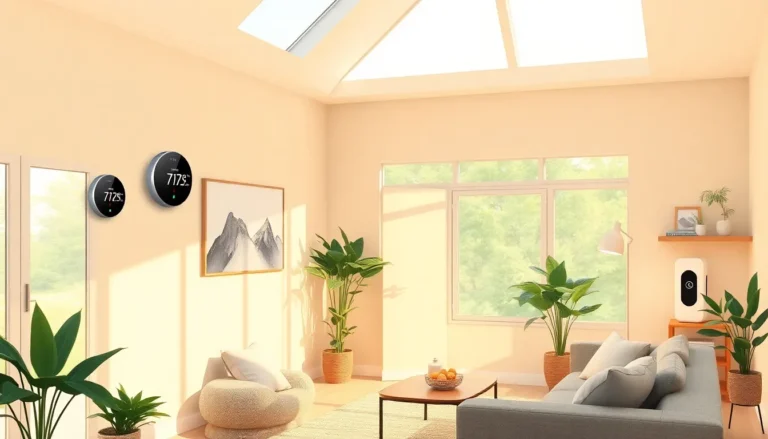In a world where juggling multiple devices feels like a modern-day circus act, “multi-device scenes” step in as the ultimate ringmaster. Picture this: you’re binge-watching your favorite show on the couch while your phone buzzes with notifications, and your tablet sits nearby, ready for a quick scroll. It’s a chaotic symphony of screens, but what if they could harmonize instead?
Multi-device scenes transform this digital chaos into a seamless experience. They allow users to sync devices effortlessly, creating a unified atmosphere that’s both convenient and fun. Whether it’s switching from a phone call to a video chat or controlling smart home devices with a swipe, these scenes make life a whole lot easier. Dive into the world of multi-device scenes, where technology meets efficiency, and discover how to turn your tech chaos into a well-orchestrated masterpiece.
Table of Contents
ToggleUnderstanding Multi Device Scenes
Multi-device scenes represent a concept that enhances user experience across various screens. These scenes allow for synchronization between devices, simplifying digital interactions.
Definition and Importance
Multi-device scenes refer to coordinated actions performed across multiple devices simultaneously. This synchronization fosters a unified experience, essential in today’s digital landscape. With devices such as smartphones, tablets, and smart TVs constantly competing for attention, streamlining interactions proves vital. Coordinated control reduces friction when transitioning between tasks. Users experience enhanced convenience, leading to improved productivity. According to a study by MIT, multitasking can lead to a 40% reduction in productivity. Thus, implementing multi-device scenes can significantly counteract this decline.
Key Components
Several key components enable effective multi-device scenes. First, seamless connectivity allows devices to communicate effortlessly. Wi-Fi or Bluetooth technologies often bolster this aspect. Second, user-friendly interfaces promote easy navigation and control across devices. Well-designed apps simplify interactions, making technologies more accessible. Additionally, automation plays a crucial role in optimizing operations. For instance, smart home devices can be programmed to respond simultaneously to specific commands. Lastly, integration of voice commands enhances convenience. By incorporating voice recognition, users streamline interactions, ensuring hands-free operation. Together, these components create an efficient and organized multi-device experience.
Benefits of Multi Device Scenes

Multi-device scenes offer significant advantages, enhancing user interactions across various platforms. These benefits include an improved user experience and increased productivity.
Enhanced User Experience
Seamless transitions between devices improve user engagement. Coordinated notifications on a smartphone can reduce distractions while watching a show on a smart TV. Effortlessly switching between tasks, like checking messages during a video call, creates a more fluid experience. Automated routines customize interactions, allowing for voice commands to control multiple devices at once. Personalized settings in multi-device scenes enhance overall satisfaction, making content consumption and communication more enjoyable.
Increased Productivity
Synchronizing tasks across multiple devices boosts efficiency. Users can easily continue working on a laptop while receiving relevant updates on a tablet. Integrated smart home controls streamline daily routines by enabling one-touch access to common functions. The ability to manage devices through automation reduces time spent on repetitive tasks. Additionally, maintaining focus on a primary device ensures that users remain productive, minimizing the chaos of juggling multiple screens. By leveraging multi-device scenes, users maximize their time and capabilities in a connected world.
How to Create Effective Multi Device Scenes
Creating effective multi-device scenes involves careful selection and integration of compatible technologies. The right setup enhances connectivity and usability across platforms.
Choosing the Right Devices
Selecting compatible devices is crucial for seamless multi-device scenes. Focus on devices that support the same ecosystems, ensuring smooth connectivity. Popular options include smartphones, tablets, smart TVs, and smart speakers. Each device amplifies user interaction by aiding communication and content sharing. Opting for devices designed for compatibility reduces setup time and technical issues. Users should consider brands known for their cohesive ecosystems. Apple, Google, and Amazon provide a variety of products that work harmoniously together. Prioritizing compatibility leads to more efficient device management and improved user experiences.
Integrating Platforms and Ecosystems
Integrating platforms creates a cohesive multi-device environment. Users benefit from linking devices through central hubs or smart assistants. Solutions like Google Home or Amazon Alexa facilitate voice control across devices, simplifying interactions. Streamlined integration ensures devices operate harmoniously, enhancing operational efficiency. Utilizing applications that support cross-platform functionality is essential. Services like Apple’s HomeKit and Google’s SmartThings provide frameworks for managing smart devices easily. Effective integration allows users to customize experiences and automate routines, resulting in enhanced productivity. Prioritizing platform compatibility maximizes the potential of a connected ecosystem, ensuring effective communication among devices.
Common Use Cases
Multi-device scenes enhance user experiences across various environments. Two notable applications emerge in home automation and collaborative workspaces.
Home Automation
Home automation exemplifies the effectiveness of multi-device scenes. Users can connect smart lights, thermostats, and security systems, allowing coordinated actions across devices. For instance, turning off the lights and adjusting the thermostat for bedtime can occur with a single command. Meanwhile, voice commands through smart assistants, such as Amazon Alexa or Google Assistant, simplify interactions. Synchronizing routines like waking up or leaving home automates daily tasks and increases efficiency. Ultimately, this seamless experience creates a more welcoming living environment, empowering users to control their homes effortlessly.
Collaborative Workspaces
Collaborative workspaces benefit significantly from multi-device scenes. Teams often engage via laptops, tablets, and smart displays to enhance communication. When brainstorming or conducting video meetings, sharing presentations can happen instantly across devices. Each participant can access shared documents, making real-time collaboration efficient and effective. Additionally, integrating productivity tools enables users to manage tasks seamlessly, keeping everyone aligned. The ability to switch between tasks on different devices fosters creativity and innovation. Hence, multi-device scenes play a crucial role in transforming collaborative efforts into productive experiences.
Challenges and Considerations
Multi-device scenes face several challenges that can hinder their effectiveness. Addressing compatibility and security is crucial for optimal user experience.
Compatibility Issues
Device compatibility represents a significant hurdle in multi-device scene implementation. Different ecosystems often limit seamless interaction among devices, causing frustration for users. Apple, Google, and Amazon ecosystem products may not always work together smoothly. Users may encounter inconsistent performance when devices from various brands attempt to synchronize. Selectively choosing compatible devices ensures the best results. By focusing on products within the same ecosystem, users can avoid unnecessary complications and maximize functionality.
Security Concerns
Security concerns arise as devices become increasingly interconnected. Unsecured devices provide potential vulnerabilities that can lead to data breaches. Multi-device scenes rely on constant connectivity, which may expose sensitive information. Employing strong passwords and enabling two-factor authentication enhances security. Regularly updating device firmware also minimizes risks. Users should be aware of the potential threats and take proactive measures to protect their data. Prioritizing security creates a safer environment while enjoying the benefits of multi-device scenes.
Embracing multi-device scenes can significantly enhance the way users interact with technology. By creating a cohesive experience across devices, individuals can streamline their routines and boost productivity. This innovative approach not only simplifies task management but also elevates user engagement through seamless transitions and automation.
As technology continues to evolve, the importance of integrating devices within compatible ecosystems cannot be overstated. Prioritizing security measures further ensures a safe and efficient digital environment. Ultimately, multi-device scenes represent a powerful tool for transforming daily life, making it easier to navigate the complexities of a connected world.








